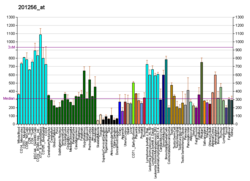Protein-coding gene in the species Homo sapiens
| COX7A2L |
|---|
|
| Identifiers |
|---|
| Aliases | COX7A2L, COX7AR, COX7RP, EB1, SIG81, cytochrome c oxidase subunit 7A2 like, SCAFI, SCAF1 |
|---|
| External IDs | OMIM: 605771; MGI: 106015; HomoloGene: 3463; GeneCards: COX7A2L; OMA:COX7A2L - orthologs |
|---|
| Gene location (Human) |
|---|
 | | Chr. | Chromosome 2 (human)[1] |
|---|
| | Band | 2p21 | Start | 42,333,546 bp[1] |
|---|
| End | 42,425,088 bp[1] |
|---|
|
| Gene location (Mouse) |
|---|
 | | Chr. | Chromosome 17 (mouse)[2] |
|---|
| | Band | 17|17 E4 | Start | 83,809,347 bp[2] |
|---|
| End | 83,824,759 bp[2] |
|---|
|
| RNA expression pattern |
|---|
| Bgee | | Human | Mouse (ortholog) |
|---|
| Top expressed in | - endothelial cell
- right adrenal cortex
- Achilles tendon
- left adrenal gland
- left adrenal cortex
- islet of Langerhans
- middle temporal gyrus
- amniotic fluid
- secondary oocyte
- beta cell
|
| | Top expressed in | - spleen
- ganglionic eminence
- uterus
- bone marrow
- pancreas
- ventricular zone
- thymus
- islet of Langerhans
- duodenum
- lens
|
| | More reference expression data |
|
|---|
| BioGPS |  | | More reference expression data |
|
|---|
|
| Gene ontology |
|---|
| Molecular function | - electron transfer activity
- cytochrome-c oxidase activity
| | Cellular component | - mitochondrial inner membrane
- membrane
- mitochondrial respirasome
- nucleolus
- mitochondrion
| | Biological process | - proton transmembrane transport
- electron transport chain
- regulation of oxidative phosphorylation
- mitochondrial respirasome assembly
- mitochondrial electron transport, cytochrome c to oxygen
| | Sources:Amigo / QuickGO |
|
| Orthologs |
|---|
| Species | Human | Mouse |
|---|
| Entrez | | |
|---|
| Ensembl | | |
|---|
| UniProt | | |
|---|
| RefSeq (mRNA) | |
|---|
NM_004718
NM_001319036
NM_001319037
NM_001319038
NM_001319040 |
| |
|---|
| RefSeq (protein) | |
|---|
NP_001305965
NP_001305966
NP_001305967
NP_001305969
NP_004709 |
| |
|---|
| Location (UCSC) | Chr 2: 42.33 – 42.43 Mb | Chr 17: 83.81 – 83.82 Mb |
|---|
| PubMed search | [3] | [4] |
|---|
|
| Wikidata |
| View/Edit Human | View/Edit Mouse |
|
Cytochrome c oxidase subunit 7A-related protein, mitochondrial is an enzyme that in humans is encoded by the COX7A2L gene.[5][6]
Cytochrome c oxidase (COX), the terminal component of the mitochondrial respiratory chain, catalyzes the electron transfer from reduced cytochrome c to oxygen. This component is a heteromeric complex consisting of 3 catalytic subunits encoded by mitochondrial genes and multiple structural subunits encoded by nuclear genes.
The mitochondrially-encoded subunits function in electron transfer, and the nuclear-encoded subunits may function in the regulation and assembly of the complex.
This nuclear gene encodes a protein similar to polypeptides 1 and 2 of subunit VIIa in the C-terminal region, and also highly similar to the mouse Sig81 protein sequence.
This gene is expressed in all tissues, and upregulated in a breast cancer cell line after estrogen treatment. It is possible that this gene represents a regulatory subunit of COX and mediates the higher level of energy production in target cells by estrogen.[6]
References
- ^ a b c GRCh38: Ensembl release 89: ENSG00000115944 – Ensembl, May 2017
- ^ a b c GRCm38: Ensembl release 89: ENSMUSG00000024248 – Ensembl, May 2017
- ^ "Human PubMed Reference:". National Center for Biotechnology Information, U.S. National Library of Medicine.
- ^ "Mouse PubMed Reference:". National Center for Biotechnology Information, U.S. National Library of Medicine.
- ^ Watanabe T, Inoue S, Hiroi H, Orimo A, Kawashima H, Muramatsu M (Jan 1998). "Isolation of estrogen-responsive genes with a CpG island library". Mol Cell Biol. 18 (1): 442–9. doi:10.1128/mcb.18.1.442. PMC 121513. PMID 9418891.
- ^ a b "Entrez Gene: COX7A2L cytochrome c oxidase subunit VIIa polypeptide 2 like".
Further reading
- Segade F, Hurlé B, Claudio E, et al. (1996). "Identification of an additional member of the cytochrome c oxidase subunit VIIa family of proteins". J. Biol. Chem. 271 (21): 12343–9. doi:10.1074/jbc.271.21.12343. PMID 8647836.
- Schmidt TR, Goodman M, Grossman LI (1999). "Molecular evolution of the COX7A gene family in primates". Mol. Biol. Evol. 16 (5): 619–26. doi:10.1093/oxfordjournals.molbev.a026144. PMID 10335655.
- Lee N, Daly MJ, Delmonte T, et al. (2001). "A genomewide linkage-disequilibrium scan localizes the Saguenay-Lac-Saint-Jean cytochrome oxidase deficiency to 2p16". Am. J. Hum. Genet. 68 (2): 397–409. doi:10.1086/318197. PMC 1235273. PMID 11156535.
- Strausberg RL, Feingold EA, Grouse LH, et al. (2003). "Generation and initial analysis of more than 15,000 full-length human and mouse cDNA sequences". Proc. Natl. Acad. Sci. U.S.A. 99 (26): 16899–903. Bibcode:2002PNAS...9916899M. doi:10.1073/pnas.242603899. PMC 139241. PMID 12477932.
- Schmidt TR, Doan JW, Goodman M, Grossman LI (2004). "Retention of a duplicate gene through changes in subcellular targeting: an electron transport protein homologue localizes to the golgi". J. Mol. Evol. 57 (2): 222–8. doi:10.1007/s00239-003-2468-8. PMID 14562965. S2CID 25021067.
- Ota T, Suzuki Y, Nishikawa T, et al. (2004). "Complete sequencing and characterization of 21,243 full-length human cDNAs". Nat. Genet. 36 (1): 40–5. doi:10.1038/ng1285. PMID 14702039.
- Gerhard DS, Wagner L, Feingold EA, et al. (2004). "The status, quality, and expansion of the NIH full-length cDNA project: the Mammalian Gene Collection (MGC)". Genome Res. 14 (10B): 2121–7. doi:10.1101/gr.2596504. PMC 528928. PMID 15489334.
- Rual JF, Venkatesan K, Hao T, et al. (2005). "Towards a proteome-scale map of the human protein-protein interaction network". Nature. 437 (7062): 1173–8. Bibcode:2005Natur.437.1173R. doi:10.1038/nature04209. PMID 16189514. S2CID 4427026.
External links



















